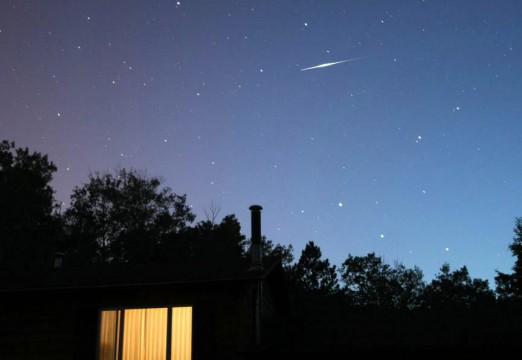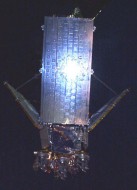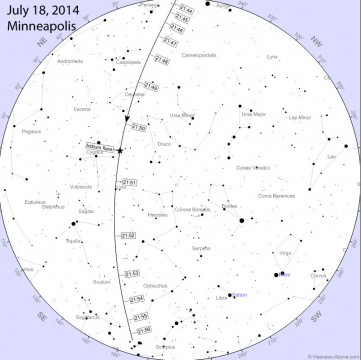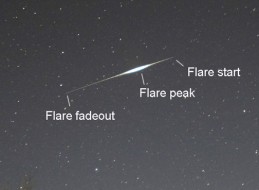The "constellation" of Iridium satellites gives stargazers frequent opportunities to predict and witness brief but dazzling blazes of light whenever one of these spacecraft directs a strong glint of sunlight toward you.

Bob King
Have you ever looked up at the night sky and watched a slow-moving "star" suddenly surge to Venus-like brightness and then disappear just as quickly? Chances are you've seen an Iridium flare. These take-you-by-surprise bursts of light are glints of sunlight from Iridium spacecraft, a "constellation" of nearly 100 communications satellites in low-altitude orbits around Earth.
Iridium spacecraft provide voice and data communications for users around the globe. The name "Iridium" derives from element number 77 on the periodic table. The satellites' owners originally planned to orbit 77 of them, but they settled for 66 and a bunch of spares. Each is equipped with three door-sized aluminum antennae treated with highly reflective, silver-coated Teflon for temperature control.

SeeSat-L
Normally these look like slow-moving faint stars, typical of many orbiting satellites. But when the Sun strikes an antenna just right, an observer on the ground sees a brilliant but brief glint of sunlight or flare. Because the orientation of most of these craft is still tightly controlled, flare times are predictable.
Iridium flares range in brightness from magnitude 1 (as bright as the star Antares or Deneb) to –8.4 (dozens of times brighter than Venus). The most dazzling opportunities are even visible in the daytime sky!
A really bright one can take your breath away. I've been lucky enough to witness a few –8 passes and can only describe the experience as alarming. It's not natural to see a starlike object glow so brilliantly. If you've ever wondered what a nearby supernova might look like, treat yourself to one of these.

Heavens-Above.com
Fortunately, witnessing one of these glints is very easy to do thanks to Chris Peat's excellent satellite-prediction website, Heavens-Above.
Once you've entered your location, simply click the Iridium flares link under the Satellites menu. You'll be directed to a page showing the coming week's worth of passes. Time, brightness, altitude, and direction are listed as well as the all-important date link. Click it for an easy-to-use sky map showing the satellite's arc across the sky, and the time and location of the flare.
Peat also includes a choice bit of additional information — the location of the flare's center line or where it will shine brightest. Just scroll down below the sky map for a ground track map showing the location of the center line. In the example above, the same Iridium satellite seen 10 km west of the city center will flare to magnitude –8.3.
Sparks in the Dark!

Bob King
Superpowers are all the rage these days. If you'd like to acquire one with little effort, peruse the list of upcoming flares and pick a convenient time to show friends and family.
Then gather everyone outdoors some minutes before the event and explain they're about to see one of the coolest sights in the sky. As everyone marvels over the artificial fireball, your superpower ability to see into the future will be secure. At least for a few minutes.
For a great resource on the topic and many more photos, visit the Visual Satellite Observer's Home Page.
Plot the exact location of your next Iridium flare on Sky & Telescope's Pocket Sky Atlas — a compact yet complete guide to the entire celestial sky.
 4
4








Comments
Kevin
July 20, 2014 at 12:18 pm
I stumbled across "Heavens Above" many years ago and thanks to that site, I saw my first ISS pass. Soon I got picky about which passes I'd "bother" with, e.g. anything less than -1 mag wasn't worth it. My all time favorite pass was seeing the space shuttle trailing the ISS shortly after the shuttle had disembarked. Many of my "non-Nerd" friends now get excited when they see the ISS pass overhead.
You must be logged in to post a comment.
Lou
July 23, 2014 at 8:36 am
I guess 'Dysprosium flares' is not quite as catchy. 😉
You must be logged in to post a comment.
Ron
July 24, 2014 at 10:45 am
Thanks for the article. My wife and I saw #13 last night at 20:59.03 hours. Could not believe how accurate Heavens Above was!
You must be logged in to post a comment.
Marc Dubbeldam
July 28, 2014 at 10:46 am
One of my all-time favourite moments was dragging the kids outside on Christmas Eve to watch "Santa Claus" fly past. The looks on their faces were priceless!
You must be logged in to post a comment.
You must be logged in to post a comment.